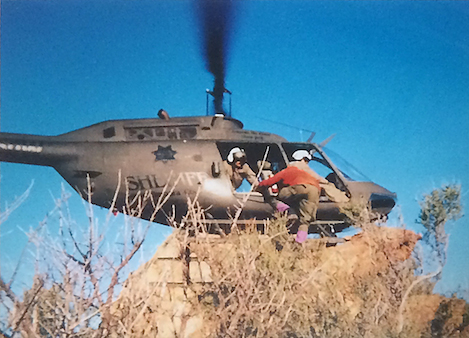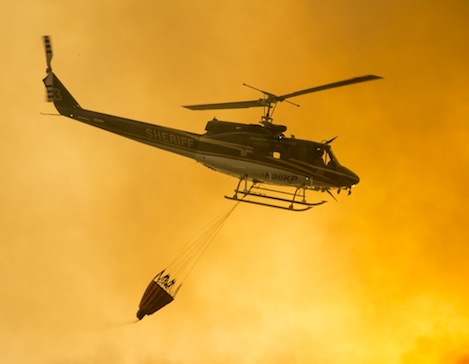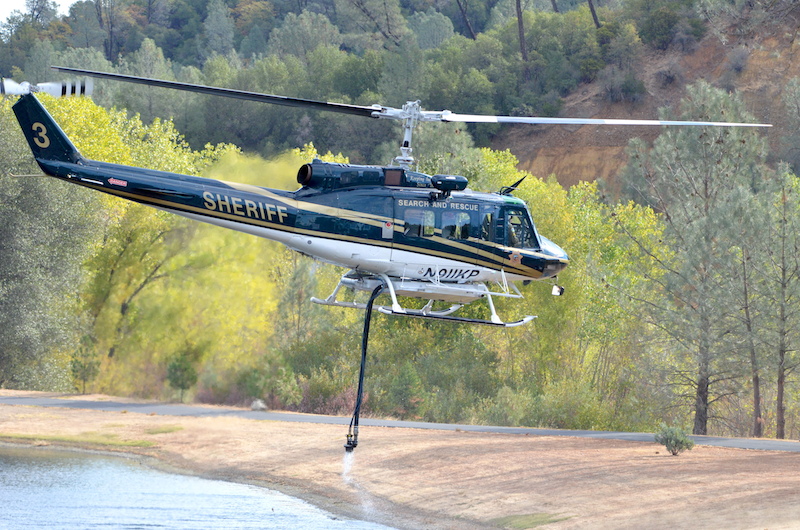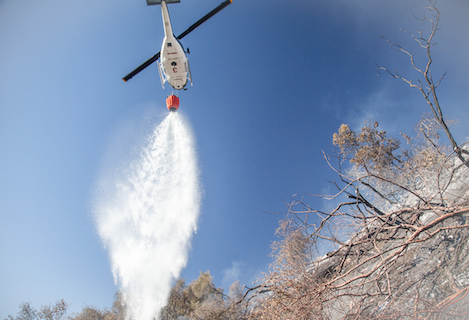Project Rescue Flight – A Lifesaver
Private Foundation Makes Backcountry Rescues a Possibility

When former Santa Barbara School Board member Lanny Ebenstein headed out on a spur-of-the-moment hike to watch the sunset one afternoon, he made three critical mistakes that almost cost him his life: he headed down an off-trail route he’d never been on before; he didn’t tell anyone where he was going; and despite being almost blind without his glasses on, he didn’t have a backup pair with him.
When he lost the one pair he had while scrambling down from La Cumbre Lookout tower down towards Cathedral Peak, Ebenstein knew he was in trouble. Not too far away, another hiker was heading up to the same area to spend a two-day retreat in the cave at the base of Cathedral Peak. Without food, water, or shelter, Ebenstein spent a cold night in the mountains, completely disoriented but aware enough to hunker down and wait for the first light.

The following morning, when he began to scramble down towards Inspiration Point, Ebenstein fortuitously crossed paths with the other hiker, Michael Nickel. Then assistant manager for the IV Food Co-op, he immediately hiked down to summon help, then guided Los Padres Search and Rescue (SAR) members back up to the spot where he had left Ebenstein.
“I immediately realized that Lanny was in no condition to walk out on his own power,” SAR team member Nelson Trichler noted. While he and others in the rescue party helped stabilize Ebenstein in the cave area, Trichler made the decision to spend the night there with Ebenstein because of his weakened condition and to request a helicopter lift out the next day from the Sheriff Department’s Aviation Bureau. Veteran pilot Gregg Weitzman and Crew Chief Jon Simon responded to the call.
Aviation Bureau
Just a year or two earlier, a high-stakes rescue like this might not have been possible. With no aircraft in their arsenal, both Search and Rescue and the Sheriff’s Department were totally reliant on Vandenberg or the nearby Ventura Sheriff’s Department for aerial support, and there was no guarantee either would be available.
Realizing Santa Barbara County needed this type of capability for rescues, fire support, and patrol in the 1980s, Weitzman began putting together a plan to acquire several helicopters. “I did a cost-benefit analysis for putting together an Air Support Unit,” Weitzman told me, “and when I realized it was feasible to do it, I did a justification paper for Jim Thomas, who was Sheriff at the time.” Fortunately for Weitzman, Thomas was supportive.

Around 1990, Weitzman also got the Department enrolled in the Federal 1208 Program that was designed to provide surplus equipment to local law enforcement departments. Within the next few years, the Sheriff’s Department was able to acquire a number of helicopters. “We got a total of four Jet Rangers from the 1208 Program,” Weitzman remembers, “and we used two of them for parts. Then we were able to get our hands on some drug asset seizure money, got some additional funds from Sheriff’s Council money and basically built two aircraft out of the four.
By late 1996, the Aviation Bureau, outfitted with the two Jet Rangers, was ready to go in service. Weitzman had spent two years putting the logistical aspects of a unit together and Simon was chosen as an Observer. “In early 1997 we had our unit up and running,” Weitzman said, “but we were flying aircraft that had been somewhat rebuilt but were pretty old. So Jon and I started talking about how to raise the funds to upgrade the choppers completely. We ended up going to the County and asking for a budget to fund a retirement and replacement program for these aircraft. The County responded that we were on your own when it came to money.”
“During the early period we were doing all of these rescues with the SAR team and we knew we needed something bigger,” Simon added. “It was just too dangerous to do the rescues in the small ships.”
The Ebenstein rescue turned out to convince Simon and Weitzman the smaller Jet Rangers weren’t robust enough for operations like that. With Ebenstein unable to get down from the peak on his own, it was up to Simon and Weitzman to do it using one of the Jet Rangers. With Crew Chief Simon readying himself to assist Ebenstein into the helicopter, Weitzman began the precarious task of lowering the aircraft down to a point where he could get one of his skids down onto a small piece of sandstone.
“Getting him off the peak with only one skid perched precariously on a rock outcropping was pretty hair raising,” Weitzman recalls. Just at the point where it appeared that things were under control, one of the members of the rescue team stepped onto the back of the skid at a point where it wasn’t touching the rock. “The copter began to pitch back and for a moment I thought we were going off the rock and down into the brush,” Weitzman said. However, with a burst of power he was able to stabilize the helicopter and get Ebenstein down safely.
“It was a close call,” Simon and Weitzman both agreed.
Project Rescue Flight
“After that we started thinking about how we could make the operations safer with a bigger aircraft,” Simon said. “We went to Sheriff Thomas and the County for funding but he told us, ‘Good luck but the county doesn’t have any money for that.’”
About that time, Simon and Weitzman began mulling over the idea of starting a private foundation to fund both larger aircraft and the parts and maintenance needed to care for them over time. After a bit of soul searching the pair decided to start a non-profit whose goal would be to purchase a brand new aircraft capable of doing everything they wanted — SAR, fire, emergency medical support, patrol and had two engines so they had the capability to go out to the islands.
“Right about that time 911 hit,” Weitzman remembers ruefully. “Funds started going east and we had a tough time getting the foundation going.” “We grew up really quickly and realized if we were going to do this it was going to be a lot of hard work and knocking on doors,” Simon chipped in. “We were two young guys who had no idea how to run a foundation or solicit money,” Simon added with a laugh. “We just thought we’d explain to some wealthy people in Montecito what we needed and they’d give us money. Didn’t happen.”
Despite the rocky start, Project Rescue Flight, eventually was able to raise the funds needed to rebuild Copter 3 and make it possible for Weitzman and Simon to realize their dream of building a robust aviation program for the Sheriff’s Department. Instead of a new helicopter they revised the plan to look for a surplus Huey instead. “It’s a great aircraft for heavy life type stuff firefighting or Search and Rescue,” Weitzman said. “If we could find one, modernize it inside and out and find the money to do we knew we’d really have something.”

From that point on Weitzman began hounding every agency listed in the Airborne Law Enforcement Association book, looking for a Huey like the one they wanted. He hit pay dirt when he got to the phone number in the book for the Jefferson County, Colorado’s Sheriff Department. “They said ‘Yah we have a Huey and we’re getting ready to auction it off.’” Weitzman added. “I said, well, why don’t you transfer it to us and we’ll rebuild it and get it going once again?” The transfer was approved by the California State Governor’s Office, which oversees the Federal Surplus Program. It was the first State to State transfer of an aircraft in this program.
Weitzman and Simon were ecstatic. “We drove back there with a semi and a flatbed, strapped it on the back of the trailer and brought it back,” Simon said. Now that they had their Huey, they needed someone who could rebuild it for them while they raised the funds to do it. Turned out there was a company by the name of Pac West in Redding, CA that was capable of doing the ground up restoration. Now it was up to them to raise the money needed for the project.
Passing the $2 Million Dollar Mark
Eventually, through their efforts, Project Rescue Flight was able to raise almost $2 million dollars for what would become Copter 3, the Huey they’d hauled back from Colorado — all from local foundations and private individuals. In the hangar at the Santa Ynez Airport where their office is located, Weitzman pointed out a number of plaques he is putting the finishing touches on for several of their donors. “While none of them want recognition for what they are doing to support us, we want them to have something to remind them how much we appreciate it.” Each of the plaques has a part from one of the helicopters affixed to it along with few words of appreciation etched along side.

Originally designed to raise the funds for Copter 3, the Foundation now supports training, maintenance and parts replacement for the aircraft. As a result of their success, the County Air Support Unit now has an additional Huey, Copter 4, in its fleet and makes it possible to provide services otherwise not possible, given the budget crises the County has gone through the past several years.
Expanded Services
Would the County be able to maintain the unit without the support of Project Rescue Flight? “Not at the current level we operate,” Weitzman replied. “Last year the foundation donated $360,000 back to the Unit. We’re capable of filling gaps the County just cannot do.” Last year, for instance, Copter 4 really needed its Moving Map system upgraded and its engines worked on. The map is a super-sized equivalent of a car’s navigation system and is critical for use on nighttime flights where visual flight is almost non-existent. “That was a $75,000 item and not something that the County budget could support,” he said.
“More important than the cost savings Project Rescue Flight has provided the County,” Simon told me, “are the lives saved since the Air Support Unit has been in existence.” (When the Sheriff’s Unit was merged with the Fire Department, it was re-named the Air Support Unit).
“I can still remember a number of calls where people were near death,” said Weitzman, particularly one in the middle of the night for two guys lost for almost two days in the backcountry. “We found these two guys,” he said. “One was fine but the other was completely dehydrated. This guy was to the point where his body was shutting down. He couldn’t walk, he couldn’t talk, he was totally out of fluids and he had already vomited everything that he had left. He was probably a few hours from death out in the middle of nowhere. The paramedics said later that he wouldn’t have made it through the night.”
Reflecting back on the last sixteen years of the Unit’s existence Weitzman noted, “We’re now a one stop shop for quick response to fires, emergency rescues and other law enforcement needs. There’s nothing else like it anywhere in the country. We were the first agency on the west coast to have the new style night vision goggles as another example of what non-profits have been able to provide and Copter 3 is the finest rescue ship you’ll find anywhere in the country.”
411
To date, Project Rescue Flight has raised almost $3.5 million dollars for the Air Support Unit. If you or an organization you support would like to contribute to the foundation, you can find out more about it at its Facebook page.
The Santa Barbara County Sheriff’s Search and Rescue Team, is a trained, all-volunteer unit of the Sheriff’s Office that is on call 24 hours a day, seven days a week. The team is looking to recruit new members who have an interest in helping others and have a love of the outdoors. No previous skills or training is necessary. Learn more by visiting www.sbcsar.org or call (805) 962-5711.



